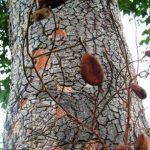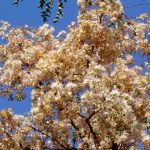TREE LIFE
APRIL 1994
MASHONALAND CALENDAR
Tuesday 5th April. Botanic garden Walk, at 4.45 for 5.00 p.m. Park at the Herbarium where we will meet Mr. Tom Muller.
Sunday 10th April. Please note the change of date; Lex and Lorna Southey will be our hosts at their farm ‘Sunnyside’ in the Concession area. Their grandchildren are the fifth generation, to grow up on the farm, Lex’s grandfather having bought the virgin farm in 1901. Lex has kindly agreed to talk a little on the farm’s history while we have tea. We will then board a trailer and be transported up the kopjie to the starting point of our walk. For the Harare folk, species not often seen so therefore of interest include Stereospermum kunthianum, Uapaca nitida, Ormocarpum kirkii, and as we found a sapling, there must be a mature specimen of Ochna gambleoides lurking somewhere.
Lorna has specifically invited anyone who does not feel like walking, to spend the day in the garden, and as Lorna is a keen member of a garden club the description of the garden is left to your imaginationThe distance from Harare is about 65 km; please aim to arrive at 9.30.
April 15-18. Trip to Renco Mine. Fully booked.
Saturday 23rd April. Botanic Interest Walk. At Cleveland Dam at 300 p.m. We meet Mark in the car park.
Tuesday 3rd May. Botanic Garden Walk.
The Herald 25 years ago. The President of the Tree Society of Rhodesia, Mr. Douglas Aylen, says the deterioration of the veld has become desperate and that immediate steps are needed.
He says the situation is far worse than official sources are willing to describe. Mr. Aylen, who will be speaking at tonight’s annual meeting of the Society at the Queen Victoria Museum, said yesterday that nearly every Tribal Trust land was suffering from severe soil damage due to mismanagement.
He said one game and ranching area, the Tuli Circle, was so ravaged by erosion that the blades of grass could be counted. Only worthless, inedible weeds were holding the sun-baked earth together, and the topsoil had been washed away. HERALD 24 February 1994
Sunday 15th May. A.G.M.
Notice of Annual General Meeting
NOTICE is hereby given that the 44th Annual General Meeting of the Tree Society of Zimbabwe will be held on Sunday 15th May 1994 at Chipping Estate at 10.00 a.m.
AGENDA
1 Notice convening the Meeting
2 Apologies
3 Minutes of the 43rd A.G.M.
4 Matters arising
5 Chairman’s report
6 Treasurer’s Report
7 Election of Committee Members.
8 Any Other Business
Any proposals/resolutions and nominations for office-bearers should be forwarded to P 0 Box 2128 Harare by Monday 9th May 1994 if possible, although proposals and nominations will be accepted from the floor.
We really do need a few more members to join the Committee; new ideas are needed and welcome. If you can spare a couple of hours a month – PLEASE come forward and don’t worry if you don’t know many trees – two will do.
Saturday 28th May. Botanic Interest Walk.
MATABELAND CALENDAR
We apologize for the unexpected rescheduling, but matters were taken out of our hands at very short notice. We have, nevertheless lost none of our planned visits, as there was no major change, except that some might have missed out on Mtshabezi because we brought it forward. We are terribly sorry if this was the case.
Monday 4th April. Please do note the change of day from what would have been Easter Sunday to Easter Monday. This will be a morning trip to Mazwi where Anton Ellert has found much of interest. Rendezvous at Girls’ College for an 8.30 a.m. departure and bring tea.
Thursday 7th April. AGM at Girls’ College starting at 7.30 p.m. with tea, coffee and a video afterwards.
Sunday 1st May. This is the rescheduled visit to the Brownlee-Walkers of Greenland Farm. Make plans for an all-day visit.
Flora of Harare and Central Zimbabwe: PROGRESS REPORT
In the Tree Life for December 1992, I put in a short note about a proposed Flora of Harare and Central Zimbabwe, based on the Central Division of Flora Zambesiaca. Work has gone well, although rather slowly and the project itself has turned out to be an absolutely fascinating one. The purpose of this short note is to put on record the species that have been added to the Central Division.
Field trips were made during 1993, usually with Maureen Silva-Jones and Andy MacNaughtan to Wedza Mountain in August, to the areas between Kadoma and Gokwe in October and again in early December, to Ngezi in May and September and to the Sanyati Communal Lands in January and March 1994.
The following species new to the Central Division were added:
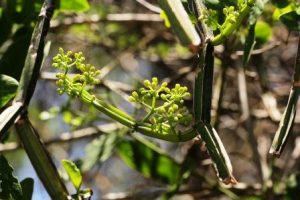
Cissus quadrangularis. Photo: Bart Wursten. Source: Flora of Zimbabwe
Cissus quadrangularis
Microglossa pyrifolia
Acacia nigrescens
Grangea maderaspatana
Cardiospermum grandiflorum (garden escape) Ipomoea carnea (garden escape)
Entandrophragma caudatum (confirmed) Strophanthus nicholsonii
Euryops chrysanthemoides (garden escape) Hibiscus seineri
However, perhaps the most interesting discovery was finding an area of lowveld within the Central Division in the Sanyati Communal lands, near Sanyati itself, which has clearly not been much collected in before. This area is at c.850 m altitude, contains Jesse and in effect has a Zambezi Valley flora.
Species added to the Central Division from here are:
Acacia tortilis, Balanites maughamii, Bauhinia tomentosa, Ceratotheca sesamoides, Cissus integrifolius, Combretum celastroides, Commicarpus plumbagineus, Croton longipedicellatus, Dalbergia martinii, Hibiscus dongolensis, Elytraria acaulis, Lonchocarpus eriocalyx ssp. wankieensis, Maerua prittwitzii, Oryza barthii, Psilotrichum scleranthum, Pteleopsis myrtifolia, Setaria sagittifolia, Strophanthus kombe, Talinum portulacifolium
In addition, Diospyros squarrosa found in the Mupfure River bed on the trip to Ijapo Farm in February was also new to the Central Division.
In total, 30 species have been added or their presence verified. Nevertheless it should be pointed out that this is only about an additional 1% of the total known flora of the Central Division.
I would like to thank Bob Drummond and Tom Muller for their vital assistance in naming specimens for me.
-MARK HYDE
A second and third visit to the eastern Matopos with Roy Stephens
At the close of our January 2 visit Roy suggested we come again as he still had much to show us. This invitation we gladly accepted and arranged a date for February 20, but Roy felt we should have a recce first. Thus on Saturday January 22 Ian and I were taken on a wonderful recce by Roy and Malcolm Rosa, over a vast granite ridge down a relatively precipitous slope into a well-wooded ravine through which we followed the water course (dry initially). Then back on to the rock face, over which the water streamed to the river, some 200 feet below. Roy and his assistant, Jabulani left us for a while. They went to collect an aloe whilst we enjoyed the sound and sight of running water in Matabeleland and Malcolm had a swim.
Roy led us up stream to one of his special treasures –a clump of Myrica pilulifera and still to be confirmed Heteromorpha trifoliata.
As we retraced our steps the storm clouds gathered, temperature and humidity rose and we reached the final hurdle, a 300-foot slog up a steep bare baking rock face in the broiling sun … mad dogs etc. This mad dog nearly was no more.
Botanically a most rewarding walk noting some 104 species of trees and shrubs including Apodytes dimidiata, Homalium dentatum, Nuxia congesta, Ochna holstii, Olax dissitiflora, Olinia vanguerioides and Zanthoxylum chalybeum to name but a few.
February 20 dawned cool and overcast as 14 of us sallied forth. The heavy rains early in the season have produced a luxuriant growth of vegetation and as the road narrowed we drove through a ‘tunnel’ as the grass reached roof height or more.
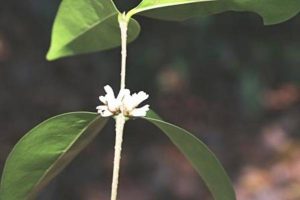
Chionanthus battiscombei. Photo: Mark Hyde. Source: Flora of Zimbabwe
We left the vehicles at Malcolm’s weekend cottage and started off down the rock face to the stream below. Of immediate interest was Chionanthus battiscombei in flower.
There being such diversity of species our progress was very slow as we followed the stream through the dense riverine growth. As the stream tumbled down a channel cut into the granite into a pool below we scattered to explore the little pockets of vegetation on the granite and found Ficus verruculosa, Ficus thonningii, Ficus cordata, Erythroxylum emarginatum and a magnificent Kirkia acuminata among others.
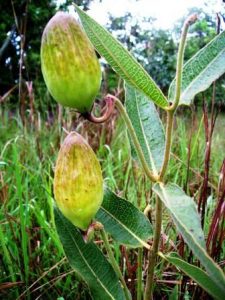
Pachycarpus lineolatus. Photo: Bill Clarke. Source: Flora of Zimbabwe
We left the river to walk through dry more open wooded grassland and found Pachycarpus lineolatus, one sporting its enormous seed case, another already exploded surrounded by a heap of silvery seeds. By this point, the morning had fled, so we made tracks for base back across the river end up through a jumbled rock fall.
Ray had to return to town, leaving us to have lunch and explore the area around the cottage. Alison pointed out the carnivorous sundews Drosera burkeana and Drosera indica growing in the water.
We noted some 102 trees and a number of shrubs, flowers and vines. A thoroughly enjoyable and rewarding visit. A big thank you to Roy for being so willing to share his wonderful piece of the Matopos with us.
A sample of sightings, Acokanthera rotundata, Antidesma venosum, Apodytes dimidiata. Cassia abbreviata, Cussonia arborea, Erythrina latissima, Erythrococca trichogyne, Ficus sur, Ficus natalensis, Ficus ingens, Ficus glumosa. Euphorbia cooperi, Euphorbia ingens, Euphorbia matabelensis, Pittosporum viridiflorum, Securidaca longipedunculata.
-Margaret McCausland
Matabeleland 6th March
Tree Society visit to Sotshe and a semi circular sweep south of Bulawayo and into the eastern foothills of the Matopos made a round trip of 200 km with at least 17 members participating.
We turned west off the old Gwanda Road and soon found ourselves in a remarkable valley with long curved and fairly high granite outcrops rising on either side of the valley at the head of which was a refreshing spilling dam on the Unquina River. The day had begun with an early chill that developed into powerful sunshine with the vast Matabeleland sky bordered with peripheral cloud by contrast emphasizing the surprising heat.
Climbing the right flank of the valley we noted an overwhelming body of Lantana camara and become conscious of Lopholaena coriifolia which plant of desperation and low degree informed us of the prevalence of overgrazing.
A delicate grass, Gomphocarpus lineolatus, growing in crevices in the rock plus Euphorbia griseola crawling about underfoot with Euphorbia schinzii, and getting a little higher off the ground was Elephantorrhiza burkei, Ceratotheca (? Species of Digitalis), the yellow flower Merramia tridentata, Tarenna zimbabwensis – all this low life rising maximally to shrubs provoked some murmuring among the panting climbers “thought we were a Tree Society”. However, straightening up and taking a broader view we were conscious of a magnificent landscape almost mountainous, a lush valley floor, the spectacular sky and splendid cloud formation and yes, there in the valley stood a large Kirkia acuminata.
Further up the hill we found the surprising Euphorbia matabelensis – so difficult to believe it belonged to that family – no surprise if it claimed kinship with the Burseraceae. Then came Combretum zeyheri, Strychnos madagascariensis, Heteropyxis dehniae, Vitex payos, Rhus leptodictya, Cissus cornifolia, Pappea capensis and at the foot of a Euphorbia ingens we found an orchid and Grewia monticola. Next was Vangueria infausta and Psydrax livida and we approached the summit was a good deposit of soil dominated by Brachystegia glaucescens, a rewardingly well-grown tree. Here also grew Erythrina latissima. Albizia antunesiana purplish on the ground, a large Terminalia sericea, Ozoroa insignis and Barleria albostellata.
On our descent we were greeted by Vepris reflexa, and a Pseudolachnostylis maprouneifolia with a huge trunk. There were plenty of Senecio barbertonicus that haunted us for the rest of the day and just for argument a Tarenna neurophylla, which remained in some doubt.
Overhead soared an Augur Buzzard who, we think, followed us to our next stopping place, whilst on the ground arose a Ficus natalensis and a representative of the Rubiaceae with curling leaf – a small shrub, no decision arrived at. Near the bottom sat a small tree pretending to be a thorn-less Acacia who turned out to be Peltophorum africanum.
So we took to the road aiming for some shade for elevenses – this might be a long tale for it certainly was a long day.
We lay under a lovely specimen of Pseudolachnostylis maprouneifolia accompanied by a Strychnos matopensis both with luxuriant berries from this vantage point we enjoyed a sweeping view of rocky terrain, a river and many burgeoning trees, or granite-ridged open country with flowing streams and this impressive Matabele sky.
After this break we drove along a winding dirt road with excellent surface and many new concrete culverts, undulating with vleis of arable and native villages and schools all growing oleanders (Nerium oleander). We passed many large Parinari curatellifolia indeed a splendid line up of impressive specimens – Julbernardia globiflora, Lannea discolor and Combretum apiculatum, Combretum collinum, Combretum erythrophyllum, Combretum imberbe, Combretum molle and Combretum zeyheri plus Brachystegia boehmii and Brachystegia glaucescens.
Pulled off the road for luncheon into a typical gem of Miombo woodland near Gulubagwhe cave. Set up our tables under a Julbernardia globiflora with a Pavetta eylesii in our midst. A red smelly parasite pervaded the area running along the branches of surrounding flora – Lannea discolor, Albizia versicolor et al.
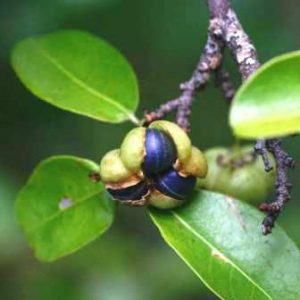
Margaritaria discoidea. Photo: Bart Wursten. Source: Flora of Zimbabwe
On our way to the cave we inspected Artabotrys brachypetalus and then were called to traipse across the road on our full stomachs to see another Euphorbia – Margaritaria discoidea with its three-lobed fruit and the blue bloom thereon. This arose from the depth of a large Antbear hole and the woodland – an extension of that in the Eastern Districts, Malawi and Tanzania – where this species can grow to 25 metres. Also grew Combretum zeyheri, Vangueria infausta, and Ozoroa insignis.
Climbed the mountain to the cave that we know is all of 60 years old because Geoff Archer had a photograph he took of it then to prove it! It contains a large centipede-like snake in ancient paint.
Proceeding on the Old Gwanda Road which I think we had rejoined we turned left and came to a Baobab (Adansonia digitata) fairly young – estimated 2 – 300 years and beside it Acacia nilotica. Another left turn and some tens of Km on a corrugated road brought us to Mtshabezi Dam, still under construction. Impressive indeed and so was the climb to top of its wall through a forest of Kirkia, Brachystegia, Clerodendrum myricoides and Artabotrys brachypetalus, whose fruit we ate on our descent of the thousands of feet (!) of wooded precipice.
An imposing site/sight, apart from a long drive home, to end a memorably day.
-Eric McNair
THORA’S HERBAL HINTS
Olive Olea europaea
One of the oldest named trees – when the dove returned to the Ark for the second time it carried a fresh branch of olive in its beak.
The Greeks made it their symbol of wisdom and only chaste men and virgins were allowed to grow it.
The Romans called it ‘the tree of Minerva’ and venerated it. Those asking for a cessation of hostilities would carry an olive branch – peace being a form of wisdom.
The tree gives the Mediterranean countries wood, leaves and fruits, in other words provides them with shelter, warmth, food and remedies.
The ancients made great use of olive oil in their food and in the care of their bodies. Athletes rubbed themselves from top to toe to keep muscles and joints supple and also employed it internally for liver complaints and gallstones.
Today olive oil is still taken for hepatic insufficiency, gallstones, biliary or renal colic, colitis and constipation – easily tolerated.
To prevent intoxication swallow a tablespoon of olive oil before wining and dining. Externally, olive oil mixed with the white of an egg, is a soothing ointment for burns and insect stings. A tea made from olive leaves is recommended for hypertension, angina pectoris and diabetes – lowers blood sugar level. The infusion is also used for cleansing wounds and promoting healing.
In some countries the leaves are used for tanning leather.
Wild Olive – Olea europaea subsp. africana
A hardy, drought and frost resistant tree, the beautiful wood of which is used in carvings. Propagation by seed is easy and the commercial olive tree has been successfully grafted on to the wild olive.
All pieces of the bark and wood left after carving is saved for kindling as the inhaled smoke cleans the head.
An infusion of the fresh leaf is an excellent eye bath and a pad of cotton wool soaked in the tea and placed over closed eyes is soothing and relaxing. The leaves boiled in water makes an effective gargle for sore throats.
A decoction of the root is used for bladder and kidney ailments.
A powdered dried leaf stops bleeding and is still used by some tribes.
The wild olive is the tree emblem of the Orange Free State.
Sand Olive Dodonaea viscosa
This tree grows amazingly quickly and pruned can make a very attractive shrub – often used as a hedge – the winged seeds germinate freely.
It has been used medicinally for many years. A tea made with the leaves and fruit is sipped to ease colic, gripes, diarrhoea and nausea.
The same brew will bring down a fever and used as a wash will cool and comfort heat rash end inflammation. Used as a gargle this tea soothes a sore throat. A tea made of the root is for coughs, colds and bronchitis.
Compresses of the leaves warmed, and placed over strained muscles and sore back will ease the strain and pain.
The winged fruits used in potpourri absorb the aromatic oils wonderfully and retain the fragrance a long time.
-THORA HARTLEY
IVORDALE FARM 20 March 1994
One tends to think of the flora in highveld margins (1200-1300 metres) as being the normal Miombo woodlands, however, there was a good deal more as we subsequently found out.
Possibly the first clue to the varied flora were the large Kirkia acuminata on the fringes of the “flat rock” parking area and also the significant numbers of late flowering Sterculia quinqueloba dotted about the granite hill. Although the generic name of Sterculia is derived from and refers to the Greek God of latrines etc, it would be interesting to know if it is the “flower power” of the pungent early blooms that brought about its name.
Commiphora mossambicensis with its distinctive yellowing leaves indicated autumnal feelings and to judge by the enthusiastic sniffing of crushed Commiphora leaves some members must have found some therapeutic value in the resinous goo!
Much muttering was heard in the thickets as faces and immature Golden Orb spiders met at close range as the webs were well camouflaged. As the female is so much larger than the male, the Araneomorphs or web dwelling spiders have developed an unusual method of courtship. Initially the male gently plucks or taps the outer strands of the female’s web and waits to see if he is welcome. If accepted he advances and after some leg rubbing does his duty rapidly as the female may change her mind arid convert her suitor into instant protein!
Also in the undergrowth a variety of Strychnos occurred with Strychnos spinosa almost dripping with unripe fruit (pity!) and some Strychnos potatorum, their small green fruits masking the toxin that lurks within the seed. The other species noted was Strychnos innocua with the characteristic smooth grey powdery bark.
The walk back to the car park produced a few other interesting bits such as Ozoroa insignis, the common name of raisin berry being most appropriate when looking at the fruit. Other large trees around were Pericopsis angolensis and Afzelia quanzensis. Within the rock cracks and shallow pockets of soil we noticed a variety of plant life, from dried out sedges to small purple coloured Portulaca and colonies of Heurnia hislopii – ideally adapted for the high and dry life they lead. However, within a short distance of the cars we followed a winding path and ended up on the wrong side of the rock, the track having misled us into a tangle of Grewia monticola.
The afternoon walk was to and up a nearby shallow kopjie with a small quarry chiselled into one side. Whilst clambering around the rocky ledges overlooking a small seasonal pool of water a surprise waited in the form of a small colony of Albizia tanganyicensis, their white trunks making a pleasing change from the now dominant and dusty looking Combretum apiculatum. This area was also delightfully colourful with an alley of Kirkia acuminata and Combretum mossambicense glowing a warm yellow in the late afternoon sun, with a few fiery red Hymenodictyon floribundum wedged in the rocks above.
From our vantage point on the kopjie we were able to have a good look at the magnificent scenery of the surrounding farms and the very broken kopjies heading away to the Shamva area where ominous black clouds were piling up – a little too fast for comfort.
After some well deserved TEA the intrepid headed out to find a small colony of Holarrhena pubescens in the confines of a nearby kopjie. We found it and luckily in flower – a delicate set of five white petals and a strong scent not unlike jasmine – very exciting, as it is normally a lowveld resident!
Although we covered a relatively small area it was pleasing to record 78 different species, some being unusual in this area. Very many thanks to the Pascoe family for letting us prowl about in this most interesting part of their farm.
-Andy MacNaughtan
Necessary Weevils
Many creatures are partial to acorns. Pooh and Piglet sang songs in their praise. Squirrels squirrel them away as winter snacks; many other animals, such as American blue jays, follow their example. These animals get through a lot of acorns – in parts of America jays may eat a fifth of the crop straight away, and bury a further half of it – but in their way they are helping the oaks. Not all of the buried acorns are recovered. Those that survive ungnawed through the winter are in a good position from which to grow into mighty oaks.
Some acorn-loving species seem to bring no such benefit. Acorn weevils regularly bore their way through a sizeable fraction of the American crop and are regarded by the people charged with worrying about such things as a pest without redeeming features. But ecology moves in mysterious ways. With his colleagues Carter Johnson of South Dakota State University has been studying the relationship between the trees, the jays and the weevils. They have found that the apparently pesky beetles may be as important as the jays in sustaining healthy oak forests.
The jays begin stocking their underground larders with acorns in September, and labour busily until November. It is hard work, and uses a lot of energy – which people used to think, came from the acorns eaten, not buried. But acorns are a relatively poor source of food. They are worth putting by for lean times, but hardly the sort of slap-up feed that hard digging requires. Like the rest of the oak, they contain tannin, a chemical that dissuades hungry herbivores by doing to the proteins they eat what it would do to a cow’s hide in the hands of a skilled tanner. Oaks were the main source of tanning chemicals until the late 19th century.
Though jays may be poor at digesting acorns, weevils do it happily, undaunted by tannin. And jays can eat weevils. Dr. Johnson’s team has found that jays fed on a diet of healthy acorns lost around six grams of weight a day. Jays fed on a mixture of acorns and weevil larvae, however, did much better. Well enough, in fact, to have the energy to stock up their winter larders. With no weevils, the jays might not plant the acorns; with no oaks, there would be nothing for the weevils to eat.
The Economist October 2nd 1993
ANDY MACNAUGHTAN CHAIRMAN


